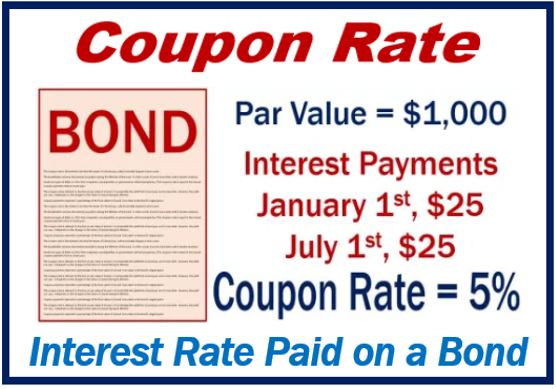Coupon rate – definition and meaning
The Coupon Rate is the interest rate that the issuer of a bond pays, which normally happens twice a year. The bondholder receives the interest payments during the lifetime of the bond. In other words, from its issue date until it reaches maturity.
Bonds are types of debts or IOUs that companies, municipalities, or governments sell and people buy.
The coupon rate equals the annual coupon payments an issuer pays. Coupon rates are relevant to the face value or par value of a bond.
Yield
It is essentially the yield that a bond pays on its issue date. However, the yield can vary. It depends on the changes in the value of a bond during its lifetime.
Coupon payments represent a percentage of the face value of a bond. Face value is the bond’s original price.
We call it a ‘coupon’ because, in the past, bonds used to have coupons. The issuer attached them.
Bond-holders would collect their interest by taking off the coupons and cashing them in. We used to call the act of tearing off the coupon ‘clipping the coupon.’
As most bonds are recorded electronically today, physical coupons are much less common.
According to the Financial Times Lexicon, the coupon rate is:
“The rate of interest paid on a bond.”

Coupon rate – example
Assume that a bond has a par value of $5,000 and a coupon rate of 5%. This would make total annual coupon payments equal to $250. For the typical bond, the bondholder would receive $125 twice a year.
Overall, investors tend to prefer bonds with higher coupon rates.
However, not every bond has a coupon. In fact, zero-coupon bonds pay no coupons and have a coupon rate of 0%.
Zero-coupon bonds only make the payment of the face value on the maturity date. People buy them at a lower price than their face value.
Coupon rate vs. yield
The bond’s coupon rate is how much income it pays in interest each year. The payment is based on its face value.
A bond’s yield to maturity is an estimate on how much the return will be. How much the return will be assuming the bondholder keeps it until it matures. In other words, assuming the bondholder does not sell it earlier.
A yield to maturity calculation factors in the coupon rate. For an investor, a bond’s yield to maturity matters more than its coupon rate.
Imagine you buy a bond with a face value of $1,000, and you receive two $25 interest payments. That bond’s coupon rate is the percentage you receive in one year. You receive $50. Therefore, its coupon rate is $5% of $1,000.
The coupons never change, regardless of what price the bond trades for, you will always get $50 per year.
If you sell your bond at a $200 premium, its yield is now equal to 4.16% ($50 ÷ $1,200 x 100 = 4.16%).
Yield to maturity tells you what your average return will be over the remaining term of the bond.
Moreover, the yield to maturity is adjusted for the bond’s current market price, which reflects changes in interest rates and the creditworthiness of the issuer.
Additionally, yield to maturity assumes that all coupon payments are reinvested at the same rate, which may not reflect actual investment opportunities available to bondholders.
Video – What Does Coupon Rate Mean?
This video presentation, from our sister channel on YouTube – Marketing Business Network, explains what the meaning of “Coupon Rate” is, using simple and easy-to-understand language and examples.

